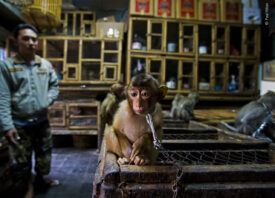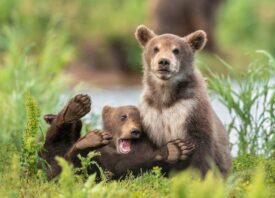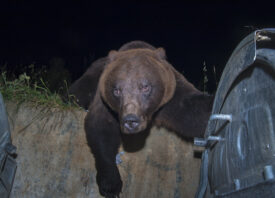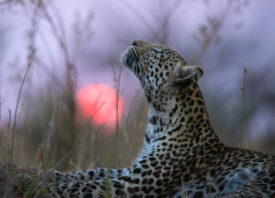Search this site
More Than 100 Photographers Are Making a Significant Difference for Wildlife. Here’s How You Can Help.

“Then it hit us: torrential rains, hectic winds, flashes everywhere. But we kept pushing, deeper into the storm, finding all sorts of angles in a landscape that felt like another planet. For a brief moment it felt as if the entire world was ours, one giant playground. After two hours, it suddenly stopped. For one minute the entire bush went to pure silence. Animals started to emerge from the thickets, including Masai giraffes, and on the horizon the warm glow of sunshine emerged. It was as if the sky was crying and laughing at the same time, and I reminded myself once again to always run into the rain, rather than away from it.”


Prints for Wildlife, now in its third year, is now open! 100% of the proceeds after printing and handling will go to African Parks, in support of the non-profit conservation organization’s mission to protect 30 parks by 2030. Prints are available through September 25th only, in limited editions of 100.
In the North of Akagera National Park in Rwanda, the photographer Marion Payr, who is also the co-founder of the Prints for Wildlife fundraiser, watched giraffes and zebras roam the vast plains and savannahs. In the South, she fell asleep to the sounds of hippos feeding. Akagera is the only Big 5 Park in the country, a safe haven for elephants, lions, leopards, rhinos, and buffalos. On Lake Ihema, you can find crocodiles basking in the sun while listening to the call of cormorants.
But it wasn’t always the magical place it is today. More than twenty years ago, Akagera was devastated by the Rwandan genocide; during this time, the lions were exterminated, and the rhinos disappeared. At one point, poaching snares numbered in the thousands.
The rehabilitation of Akagera comes down to the tireless efforts of the Rwandan government and the non-profit organization African Parks, who have been managing the park since 2010. Lions, black rhinos, and white rhinos were reintroduced in 2015, 2017 and 2019, and 2021, respectively. The park provides direct support for 300,000 people.
Now, African Parks is currently in discussions with governments across the continent to preserve extraordinary and irreplaceable places and support the local communities that care for them. Right now, 22 parks fall under their management–including forests like Nyungwe National Park in Rwanda, which they have managed since 2020. Nyungwe is one of the country’s oldest rainforests, home to a quarter of Africa’s primate species and more than 322 recorded bird species.
The organization’s goal is to reach 30 parks by 2030, with the next few years being critical for conservation and the mitigation of climate change. Estimates place the standing carbon in African Parks’ current portfolio at half a billion tons.
Prints for Wildlife, which has supported African Parks since 2020, is an unprecedented fundraiser bringing together the work of more than 130 photographers in 2022, with more than 220 having participated over the last three years. In 2020 and 2021, they raised a combined $1.75 million, with 100% of the proceeds after printing and handling directly donated to African Parks. This year, the limited fine art prints are available for just $100 through September 25th only.
Featuring internationally renowned photographers, Prints for Wildlife 2022 includes once-in-a-lifetime pictures from around the continent, featuring cheetahs and flamingos in Kenya, hippos in Zimbabwe, elephants in Malawi, zebras and rhinos in Tanzania, lions in Zambia, gorillas in the Republic of Congo, leopards in Botswana, oryx in Namibia, and a pangolin (the world’s most-trafficked animal) in South Africa–to name just a few.
This year’s collection is a stunning testament to our planet’s biodiversity–with photographers introducing us to orangutans in Indonesia, tigers in India, Arabian oryx in Dubai, and bears in Slovenia. You can find manta rays in Western Australia, dolphins in New Zealand, sperm whales in Dominica, hammerhead sharks in the Bahamas, and sea lions from Mexico. Plus, bison in Yellowstone, foxes in Alaska, and horses in Utah. Elsewhere, you’ll discover polar bears in the frozen landscapes of Norway and penguins from Antarctica.
Each year, the two founders of Prints for Wildlife, Marion Payr and Pie Aerts, each donate a photograph of their own. For 2022, Payr chose a picture she made while visiting Rwanda’s Akagera National Park with African Parks. Six individual Masai Giraffes, an endangered species, were first introduced to the park in 1986. A survey from March of this year revealed that there are now more than 100 individuals living in the park. In Payr’s portrait,* a mother giraffe nuzzles her child–a new addition to the growing population.
Every print is available in an edition of 100. Once they’re gone, they’re gone forever, so grab yours today. Follow Prints for Wildlife at @printsforwildlife on Instagram, and sign up for their newsletter for updates. *Find Payr’s photo third from the top of this story, above.


“Mountain gorillas are a conservation success story. Thanks to conservation efforts and cooperation between Rwanda, Uganda and DRC, the three countries where mountain gorillas live, their numbers have risen gradually over the past 30 years. The Virunga population, estimated to be down to 250 gorillas in the 1980s, has more than doubled to above 600. Gorillas have been relisted by the International Union for Conservation of Nature (IUCN) from ‘Critically Endangered’ to ‘Endangered’. As long as the animals and their habitats continue to be protected, hopefully mountain gorillas will continue to thrive.”




“So I quickly decided to position ourselves to get the mound with the sunset behind and hopefully one of the cheetah. After waiting a few minutes, one of the cheetah took the direction of the mound and setup on top just at the right time to create this amazing silhouette. Just a nice touch to remember that in wildlife everything can always happen, even after a quiet day. Always be ready for something, and then wait.”

“Then we turned the corner into a bay within the fjord to find a large pod coming directly towards us. We turned off the boat, slowly slipped into the water and saw this incredible pod swim gracefully right by us. To see orcas above the surface is one thing, but to be in their environment under the surface takes your breath away. Moments like this last only seconds but the memories and the feelings are for a lifetime.”








